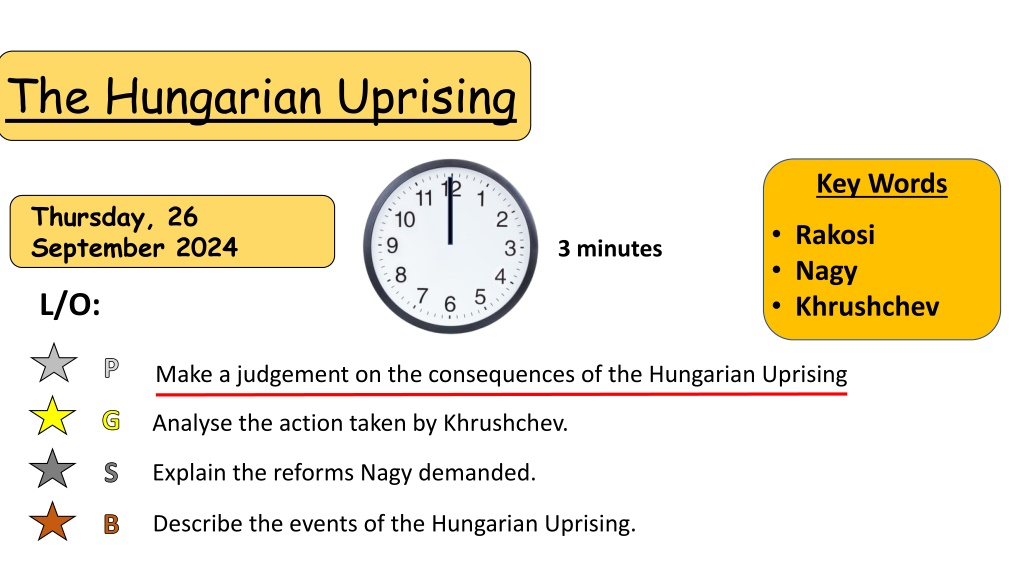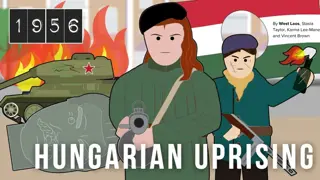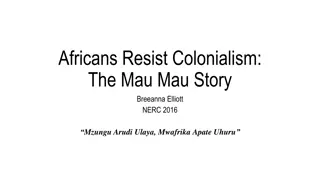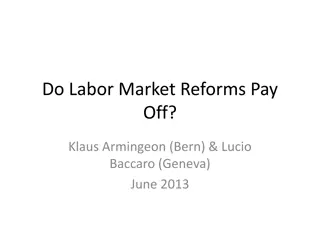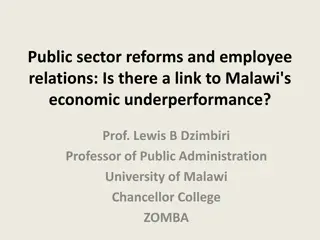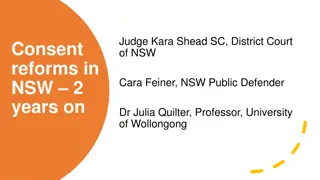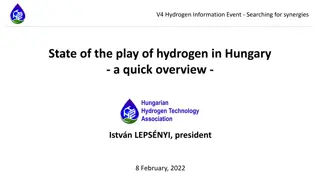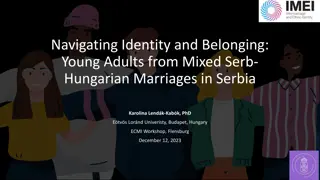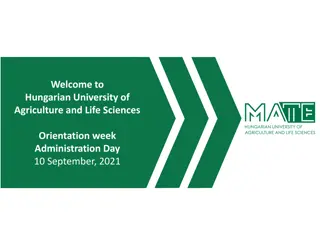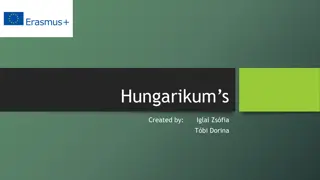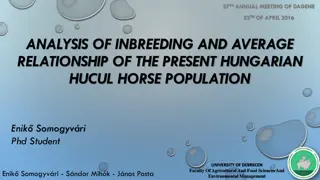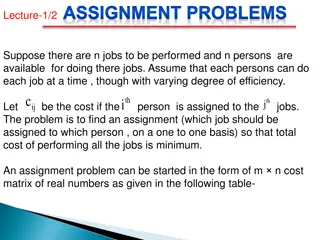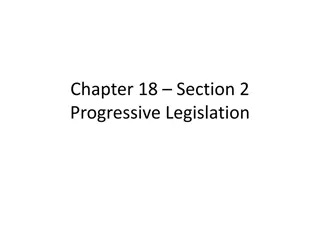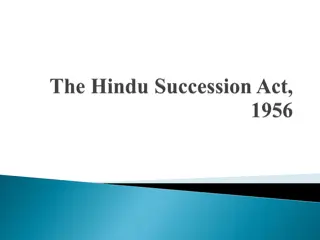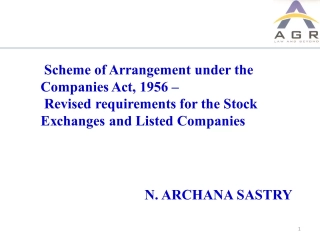The Hungarian Uprising of 1956: Consequences and Reforms
The Hungarian Uprising of 1956 was a pivotal event in Hungary's history, marked by protests against Soviet oppression and the leadership of Matyas Rakosi. Khrushchev's decision to replace Rakosi with Imre Nagy reflected a shift in Communist leadership. The demands for free speech and withdrawal of Soviet troops culminated in fierce fighting, leading to significant consequences for Hungary and the Soviet Union.
Download Presentation

Please find below an Image/Link to download the presentation.
The content on the website is provided AS IS for your information and personal use only. It may not be sold, licensed, or shared on other websites without obtaining consent from the author. Download presentation by click this link. If you encounter any issues during the download, it is possible that the publisher has removed the file from their server.
E N D
Presentation Transcript
The Hungarian Uprising Key Words Thursday, 26 September 2024 Rakosi Nagy Khrushchev L 3 minutes L/O: P Make a judgement on the consequences of the Hungarian Uprising Game over G Analyse the action taken by Khrushchev. S Explain the reforms Nagy demanded. B Describe the events of the Hungarian Uprising.
Power of 3 Last lesson What was the Arms Race? Last week Name one consequence of the Berlin Crisis? Last year: Who was Joseph Goebbels?
Who took over when Stalin Died? When Stalin died in 1953, for the first time in 29 years the USSR had a new leader. Nikita Khrushchev took over. In 1956, Khrushchev made a speech criticising Stalin something that no- one did for fear of death. He spoke of de-Stalinisation. The US thought it might signal a change in the relationship however they were wrong. His ideas were very similar. Task: Copy notes using the subheading who took over when Stalin died? Nikita Khrushchev Leader of the USSR from 1953
Hungary - 1956 Soviet Take- Over Before 1949 Hungary had been part of the Austro-Hungarian Empire. This was something that they were very proud of. 1949 Soviet Union established a Soviet Government in Hungary. They were now ruled by Communists.
Task: Using your medal tasks answer the question to the right Questions What can you see? Who might have done this and why? What does this tell us about Hungary?
Who was in charge in Hungary? Until 1956, Hungary was led by Matyas Rakosi. Stalin was a big fan of Rakosi because he did exactly what he wanted. Rakosi had a secret police he used to get rid of opponents. Hungarian people had to pay to have Soviet troops in the country. Street signs, shop signs and schools were all in Russian. People in Hungary were angry due to: Oppression Fuel shortages Matyas Rakosi Leader of Hungary until 1956 Food shortages
Task make notes on the following: What did they do about it? Appalled by the conditions in Hungary the people, forced into action by OFF protested on the streets of Budapest. They demanded free speech and the withdrawal of the Soviet troops. Stalin s statue was smashed and there was fierce fighting between Hungarian people and Soviet troops. Khrushchev decided to replace Rakosi with Imre Nagy a popular communist politician, who he hoped would settle the people.
Imre Nagy Now he s gone too far! Putting Nagy in charge settled things down and the Soviet troops left. However, even though he was a communist, Nagy was keen for change. He demanded: Free elections A fair legal system Total withdrawl of Soviet troops Private land ownership Hungary be allowed to leave the Warsaw Pact (01 Nov 1956) Imre Nagy Hungarian leader from 1956.
4th November 1956: The Soviets sent in the Red Army Why would the USSR do this?
What happened next? The Red Army, backed by 1000 tanks, rolled into Hungary and killed approximately 20,00 Hungarians to re- establish power. Nagy and the other rebels had assumed that there would be support from the USA it never came. A pro-communist, pro-USSR government was set up under Janos Kadar. Kadar promised Nagy a safe escape. He lied. Nagy was executed. Janos Kadar replaced and murdered Imre Nagy.
Creating your timeline Using the completed table (slide 13) of events, finish of the timeline adding the correct events in the correct order. 10 Minutes Challenge Task Did Khruschev have any choice but to crush Hungary and Nagy the way he did?
People of Hungary began to protest about their lack of political freedoms caused by fuel shortages and poor harvests. This led to riots in the capital Budapest. Within days of his appointment Nagy announced a set of proposed reforms. He reorganised the Hungarian government to include members of non- communist parties, ending the one-party state in Hungary. Khrushchev was prepared to accept these reforms if they calmed the unrest in Hungary. Khrushchev therefore ordered a soviet invasion of Hungary. 1000 tanks rolled in Budapest. Supporters of Nagy begged the west for support but this did not come. It was estimated that 20,000 Hungarians were killed. Nagy and several members of his cabinet sought refuge in Yugoslav embassy. Kadar had promised that Nagy and his followers could leave the country safely but had executed him instead. Khruschev has described this as a lesson to the leaders of socialist countries . International reaction to the soviet invasion of Hungary What was the impact of the Hungarian Uprising on international relations?
People of Hungary began to protest about their lack of political freedoms caused by fuel shortages and poor harvests. This led to riots in the capital Budapest. Soviet troops restored order, but Khrushchev decided to replace Rakosi with Imre Nagy. He was a former prime minister who believed that within a communist regime there should still be personal freedoms. Khrushchev hoped his appointment would end the protests. Within days of his appointment Nagy announced a set of proposed reforms. He reorganised the Hungarian government to include members of non- communist parties, ending the one-party state in Hungary. Khrushchev was prepared to accept these reforms if they calmed the unrest in Hungary. However, on 1 Novemeber 1956 Nagy announced that Hungary would leave the Warsaw Pact, Khrushchev could not allow this as it could influence others to leave. This would threaten the security of the Soviet Union . Khrushchev therefore ordered a soviet invasion of Hungary. 1000 tanks rolled in Budapest. Supporters of Nagy begged the west for support but this did not come. It was estimated that 20,000 Hungarians were killed. A new pro- communist government was set up under Janos Kadar. What was the impact of the Hungarian Uprising on international relations? Nagy and several members of his cabinet sought refuge in Yugoslav embassy. Kadar had promised that Nagy and his followers could leave the country safely but had executed him instead. Khruschev has described this as a lesson to the leaders of socialist countries . International reaction to the soviet invasion of Hungary
The International reaction to the Hungarian Uprising Since the US had offer aid in the form of the Marshall Plan and wanted to contain communism people in Eastern Europe assumed that they would help in other ways. Some NATO countries did take Hungarian refugees. There was NO military support offered the USA showed were they stood. They would not support any country that was already communist. The risk of a nuclear from USA involvement war was too great
Explain two consequences of the Hungarian Uprising (8 marks) Consider: Khrushchev and the USSR looked strong and forced all other Warsaw Pact members to be obedient. The USA looked weak. Communist countries now knew the USA would not help them. The United Nations did nothing and looked weak. The relationship between the USSR and USA worsened. Writing Frame x 2 One consequence of the Hungarian Uprising was (1) For example (1) This meant that (1) Therefore (1)
